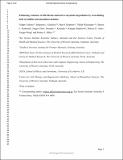Files in this item
Enhancing resistance of silk fibroin material to enzymatic degradation by cross-linking both crystalline and amorphous domains
Item metadata
| dc.contributor.author | Valente, Filippo | |
| dc.contributor.author | Allardyce, Benjamin J. | |
| dc.contributor.author | Hepburn, Matt S. | |
| dc.contributor.author | Wijesinghe, Philip | |
| dc.contributor.author | Redmond, Sharon L. | |
| dc.contributor.author | Chen, Jingyu | |
| dc.contributor.author | Kennedy, Brendan F. | |
| dc.contributor.author | Rajkhowa, Rangam | |
| dc.contributor.author | Atlas, Marcus D. | |
| dc.contributor.author | Wang, Xungai | |
| dc.contributor.author | Dilley, Rodney J. | |
| dc.date.accessioned | 2021-02-05T00:39:17Z | |
| dc.date.available | 2021-02-05T00:39:17Z | |
| dc.date.issued | 2020-04-13 | |
| dc.identifier | 267879436 | |
| dc.identifier | 17809e8d-543b-4dda-92a5-2b32fb67a97a | |
| dc.identifier | 85083882234 | |
| dc.identifier | 000526319100057 | |
| dc.identifier.citation | Valente , F , Allardyce , B J , Hepburn , M S , Wijesinghe , P , Redmond , S L , Chen , J , Kennedy , B F , Rajkhowa , R , Atlas , M D , Wang , X & Dilley , R J 2020 , ' Enhancing resistance of silk fibroin material to enzymatic degradation by cross-linking both crystalline and amorphous domains ' , ACS Biomaterials Science and Engineering , vol. 6 , no. 4 , pp. 2459-2468 . https://doi.org/10.1021/acsbiomaterials.9b00873 | en |
| dc.identifier.issn | 2373-9878 | |
| dc.identifier.other | ORCID: /0000-0002-8378-7261/work/74118147 | |
| dc.identifier.uri | https://hdl.handle.net/10023/21381 | |
| dc.description.abstract | Silk fibroin (SF) membranes are finding widespread use as biomaterial scaffolds in a range of tissue engineering applications. The control over SF scaffold degradation kinetics is usually driven by the proportion of SF crystalline domains in the formulation, but membranes with a high β-sheet content are brittle and still contain amorphous domains, which are highly susceptible to enzymatic degradation. In this work, photo-cross-linking of SF using a ruthenium-based method, and with the addition of glycerol, was used to generate robust and flexible SF membranes for long-term tissue engineering applications requiring slow degradation of the scaffolds. The resulting mechanical properties, protein secondary structure, and degradation rate were investigated. In addition, the cytocompatibility and versatility of porous micropatterning of SF films were assessed. The photo-cross-linking reduced the enzymatic degradation of SF in vitro without interfering with the β-sheet content of the SF material, while adding glycerol to the composition grants flexibility to the membranes. By combining these methods, the membrane resistance to protease degradation was significantly enhanced compared to either method alone, and the SF mechanical properties were not impaired. We hypothesize that photo-cross-linking protects the SF amorphous regions from enzymatic degradation and complements the natural protection offered by β-sheets in the crystalline region. Overall, this approach presents broad utility in tissue engineering applications that require a long-term degradation profile and mechanical support. | |
| dc.format.extent | 10 | |
| dc.format.extent | 3780988 | |
| dc.language.iso | eng | |
| dc.relation.ispartof | ACS Biomaterials Science and Engineering | en |
| dc.subject | Cross-link | en |
| dc.subject | Degradation | en |
| dc.subject | Silk fibroin | en |
| dc.subject | Tissue engineering | en |
| dc.subject | QC Physics | en |
| dc.subject | Biomedical Engineering | en |
| dc.subject | Biomaterials | en |
| dc.subject | DAS | en |
| dc.subject.lcc | QC | en |
| dc.title | Enhancing resistance of silk fibroin material to enzymatic degradation by cross-linking both crystalline and amorphous domains | en |
| dc.type | Journal article | en |
| dc.contributor.institution | University of St Andrews. School of Physics and Astronomy | en |
| dc.identifier.doi | 10.1021/acsbiomaterials.9b00873 | |
| dc.description.status | Peer reviewed | en |
| dc.date.embargoedUntil | 2021-02-05 |
This item appears in the following Collection(s)
Items in the St Andrews Research Repository are protected by copyright, with all rights reserved, unless otherwise indicated.

